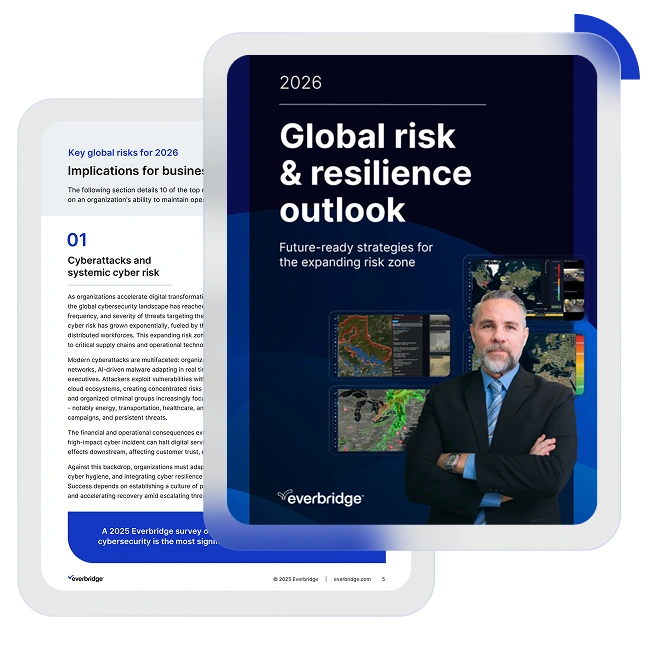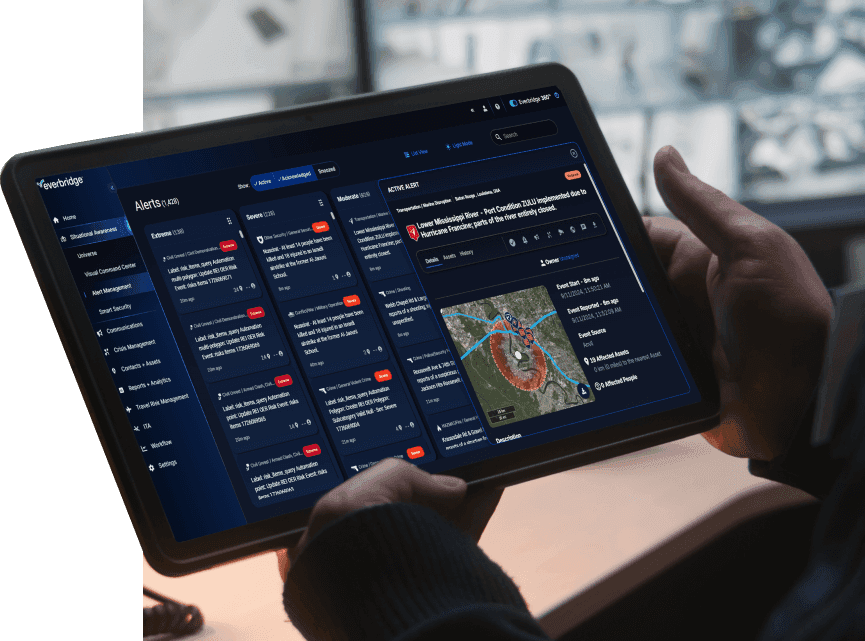Key insights from the 2026 global resilience report
The global risk landscape is shifting, with threats becoming more complex and interconnected. To understand the challenges ahead, it’s crucial to look at the data. Our “2026 Global risk & resilience outlook” provides a data-driven view of the key threats organizations face. This blog breaks down the essential statistics and figures from the report, offering a clear picture of what the numbers tell us about the future of risk.
The state of organizational resilience
Recent survey data reveals significant gaps in how organizations are preparing for critical events. The numbers highlight a disconnect between the awareness of risks and the readiness to manage them.
A 2025 Everbridge global survey found that only 31% of leaders are extremely confident in their organization’s ability to manage critical events. This lack of confidence is mirrored in their strategies, with 50% of respondents reporting they have limited or no formal critical event management strategies in place.
Further compounding the issue is a lack of preparedness and planning. The survey revealed that 24% of organizations never test their business continuity or critical event management plans. When it comes to funding, 64% of leaders reported that their organization allocates less than 5% of its annual budget to this area or were unsure of the amount.
Top threats by the numbers
When asked about the most significant threats, business leaders pointed to several key areas. Cybersecurity stands out as the primary concern for 53% of organizations. This is followed by economic downturns, natural disasters, workforce challenges, and geopolitical conflicts.
The report also sheds light on specific weaknesses. Insufficient employee training was identified as the top weakness by 29% of respondents, while 26% cited limited investment in modern tools and technology. A striking 61% reported no investment in advanced technologies like AI or predictive analytics, highlighting a major gap in leveraging tools that could improve readiness.
A deep dive into key risk statistics
The report explores ten critical global risks, each supported by compelling data that illustrates its potential impact on business continuity.
Cyberattacks and AI
The average cost of a data breach has reached $4.44 million, a figure that doesn’t fully account for operational disruptions. Gartner projects that by 2027, 60% of organizations will fail to adopt resilience principles, leaving them vulnerable to global technology threats.
Artificial intelligence presents a dual-edged sword. On one hand, it amplifies threats. Deloitte projects that generative AI could inflate fraud losses in the U.S. to $40 billion by 2027. On the other hand, a separate study showed that 44% of executives see a lack of in-house expertise as a barrier to AI adoption, slowing down its defensive potential.
Natural disasters and climate extremes
Climate-related incidents are a growing concern. The total global economic losses from natural disasters rose to $162 billion in the first half of 2025. In the past year, 69% of incidents tracked by the Everbridge Risk Intelligence Monitoring Center were climate-related, including wildfires, floods, and hurricanes. The economic toll is immense, with the Los Angeles wildfires alone estimated to have caused $53 billion in losses.
Misinformation and disinformation
The threat of false narratives is accelerating. The World Economic Forum’s Global Risks Report identified misinformation and disinformation as the most severe global risk over the next two years. The speed of these attacks is notable; a recent deepfake livestream impersonating Nvidia’s CEO reached over 100,000 viewers before being stopped, showing how quickly false information can spread.
Talent and workforce challenges
Demographics and skills gaps pose a significant operational risk. According to the World Health Organization (WHO), by 2030, about one in six people worldwide will be over the age of 60, speeding up the aging of the global workforce. The World Economic Forum notes a paradox where executives see both workforce overcapacity and severe shortages in critical areas.
Polycrises: The convergence of risks
The concept of multiple, interconnected crises happening at once is a defining challenge. The World Economic Forum’s report highlights that a majority of respondents (52%) anticipate an unsettled global outlook over the short term (next 2 years). This convergence of threats, from geopolitical conflict to supply chain shocks, creates a complex environment that is difficult to navigate with traditional, siloed response plans.
A data-driven path forward
The statistics paint a clear picture: the risk environment is becoming more intense and interconnected. From the 53% of leaders citing cybersecurity as their top threat to the 24% of organizations that never test their plans, the data reveals both the scale of the challenge and the current gaps in preparedness. The numbers show that building resilience requires a proactive, informed, and tested approach. By focusing on these data points, organizations can better understand their vulnerabilities and take meaningful steps to prepare for the expanding risk zone of 2026 and beyond.
Watch the on-demand: “Navigating the expanding risk zone: The 2026 global risk and resilience outlook” with Everbridge CEO, Dave Wagner, and Chief Security Officers, Tracy Reinhold and Pamela Larson


